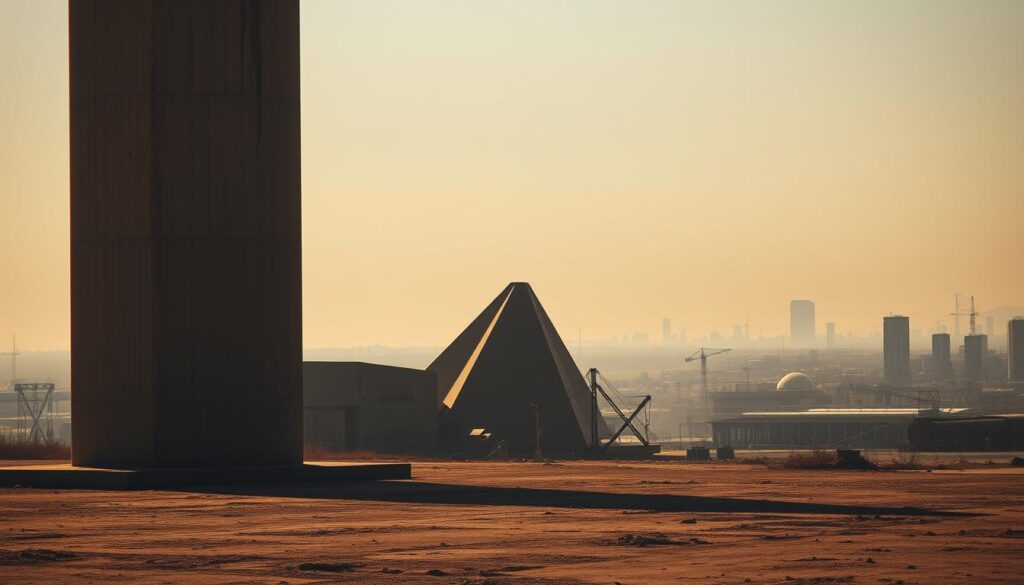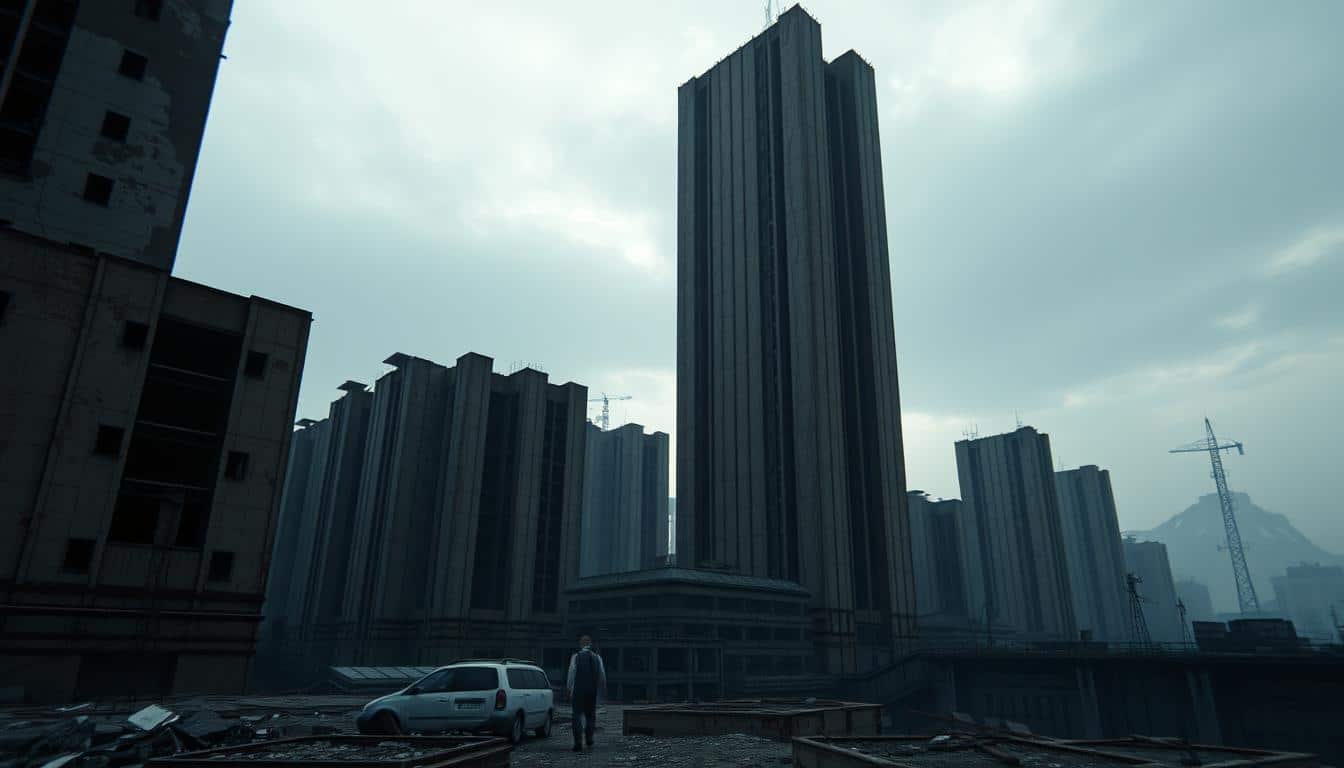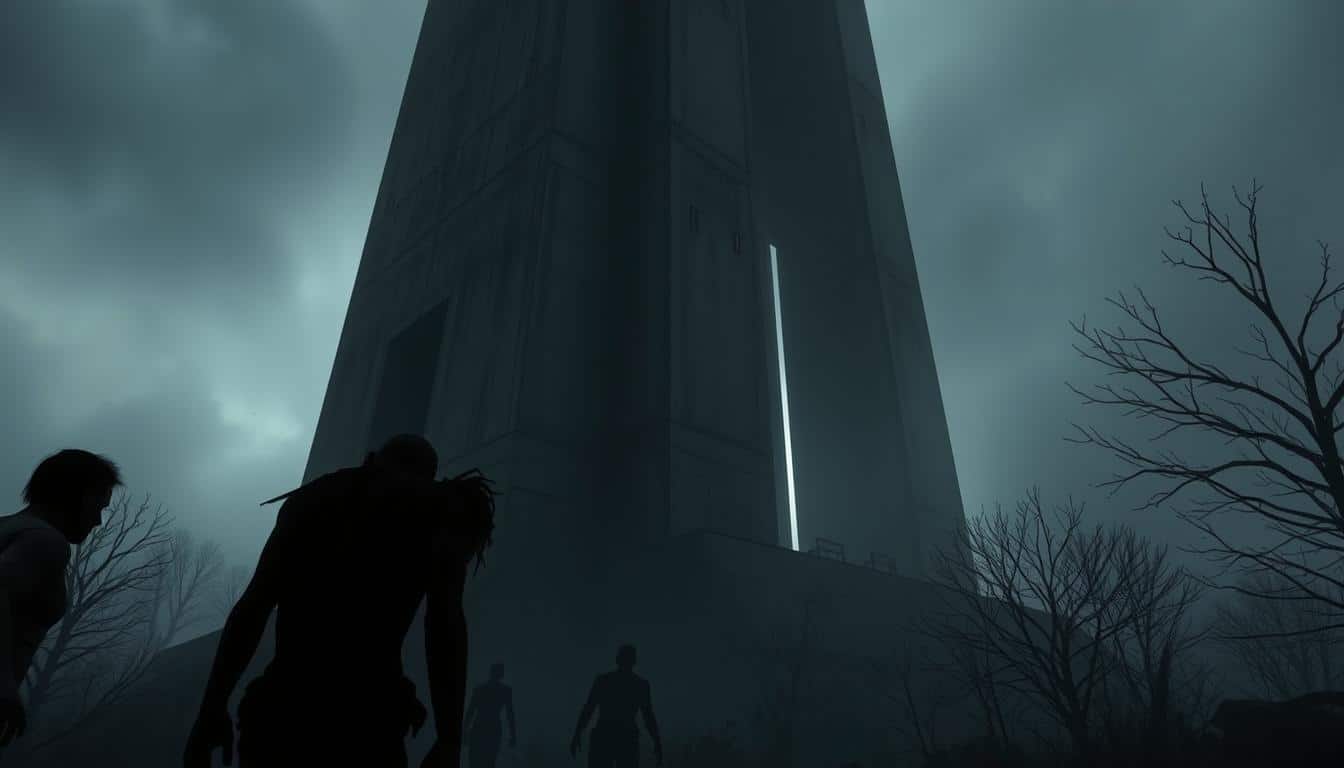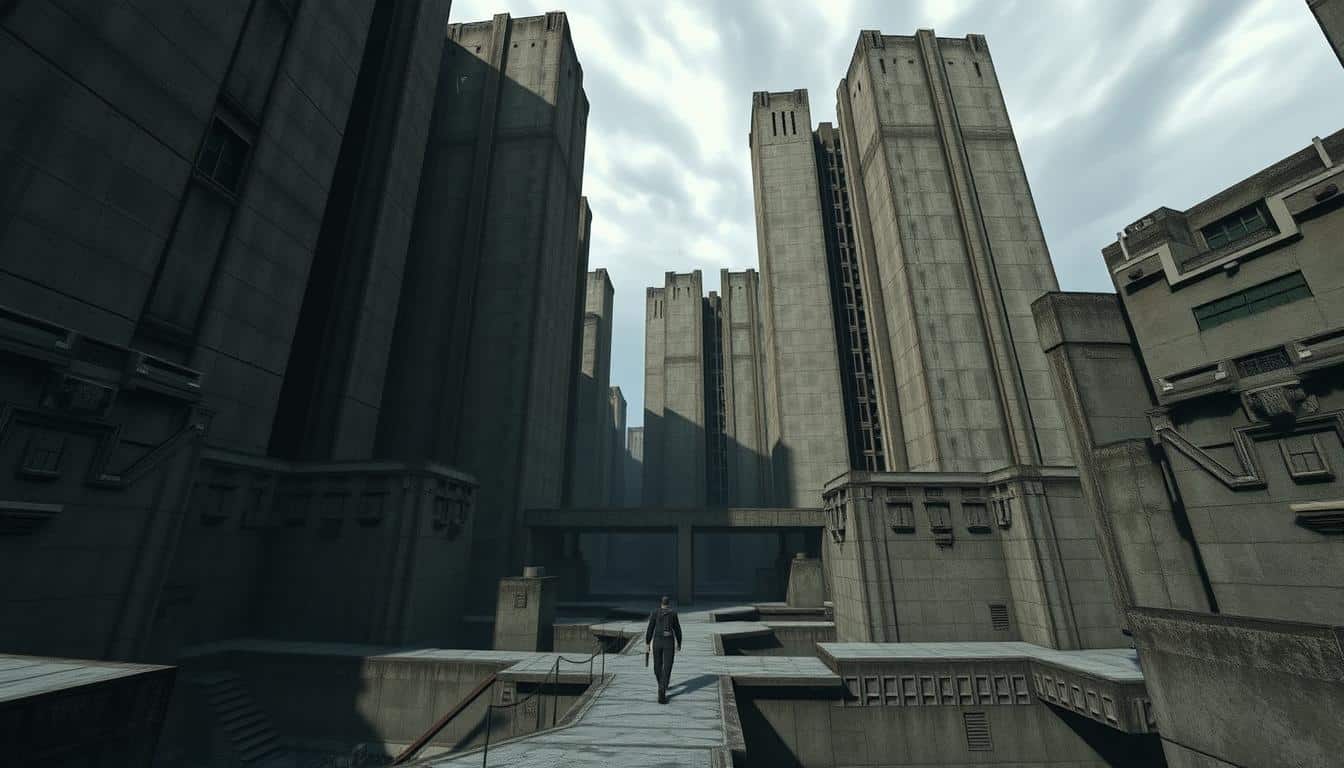Soviet brutalism and gaming aesthetics merge to form a unique story. This style is known for its simple concrete shapes and exact geometry. It has deeply influenced the look and themes in video games today.
This architectural style did more than change places. It inspired game makers to craft worlds filled with starkness and dystopia. By looking into Soviet brutalism’s deep effect, we learn how it changed the gaming world. It made games more engaging and broke the usual design rules.
The Origins of Soviet Brutalism
Soviet brutalism emerged from the ruins of World War II. It aimed to rebuild cities quickly and affordably. Architects used concrete to make large, geometric buildings that were strong and lasting.
Brutalism’s roots go back to Le Corbusier, who liked designs that were functional and simple. Alison and Peter Smithson also influenced brutalism. Their ideas were tweaked in the Soviet Union to highlight socialism’s goals, like fairness and togetherness.
Brutalism’s style is about being real and leaving off extra decorations. This approach matched the era’s social dreams and helped rebuild faster.

Key Characteristics of Soviet Brutalism
Soviet brutalism stands out with features that show off strength and purpose. This style is known for its big concrete buildings, which celebrate the look of raw materials. A key trait is the “béton brut” or unfinished concrete, giving buildings a unique, rugged feel.
This architectural style also includes repeating shapes, showing off simple geometric forms that highlight its practical side. It aims to reflect society’s values of the time, blending how a building works inside with its outside look. This creates a striking visual impact that draws people’s attention.
Key attributes of Soviet brutalism include:
- Massive and monumental scale
- Emphasis on geometric shapes
- Use of raw, unfinished materials
- Integration of social and ideological elements
- A visual representation of structural integrity and honesty
Soviet Brutalism’s Influence on Architecture
Soviet brutalism has left a huge mark on how buildings are designed worldwide, especially in places that were or are socialist. This style has encouraged architects to take its key ideas and make them work locally. They’ve mixed brutalism’s bold look with local traditions, spreading its influence far and wide.
The movement is known for more than just its looks. It also brings up important ideas about usefulness and community. Soviet brutalism’s impact is still seen today in new buildings. These buildings reflect brutalism’s ideals but also think about today’s challenges like being green and helping society.
So, the ideas behind Soviet brutalism keep shaping the way we build things. Its influence is seen all over the world, long after it started.
The Rise of Brutalism in Gaming Aesthetics
Brutalism in gaming shows a growing love for simple design. Developers are using brutalist architecture to make gaming environments better. This change brings new kinds of beauty to games, encouraging players to think and get involved.
Modern games often use raw materials and big, simple shapes from brutalism. These choices stand out from the industry’s usual detailed and shiny styles. Many games now let players explore places that feel like big, concrete buildings and open spaces.
Combining brutalism with gaming isn’t just about looks. It links games to stories about dystopia, loneliness, and criticizing society. Players don’t just play these games; they explore deep feelings and architectural history.
Analyzing the Soviet Brutalism Impact on Gaming Aesthetics
The Soviet brutalism impact on gaming aesthetics is deep. It influences game environments and character design greatly. Developers use this bold style to make worlds that show strength, isolation, and a stark reality. The intense impact and feelings from brutalism shape games’ looks and themes today.
Game Environments Reflecting Brutalist Design
Game environments show the big, imposing structures of brutalist architecture. Key features are:
- Stark landscapes without decorations
- Big concrete buildings that feel oppressive
- Striking harsh lines and angular shapes
- Huge designs that make places feel empty
These parts come together to show complex society structures. They let players move through worlds that tell stories of hard times and falling apart.
Character Design Inspirations from Soviet Architecture
Character design in games takes a lot from brutalist architecture too. Designers choose:
- Tough looks that choose function over beauty
- Simple and raw clothing styles, like concrete
- Big geometric shapes in character features, showing strength
This makes the game feel better by letting characters show the themes and feelings of their worlds. The brutalist ideas help players feel connected to the big story, feeling the world’s heavy atmosphere.
The Connection Between Brutalism and Dystopian Themes in Gaming
Brutalist architecture and dystopian themes go hand in hand in gaming. These buildings, made of raw concrete with sharp shapes, show decay and control. They fit perfectly in games about societies falling apart and feeling alone.
In these games, brutalist buildings make landscapes that feel cold and unwelcoming. They mirror the harsh worlds players explore. This design connects with players, letting them feel the heavy themes of oppression and loneliness themselves.
Games use these buildings to show societies in decline, criticizing our world. Brutalism isn’t just a backdrop; it’s key to telling the story. It makes the game’s world feel real while pointing out the flaws in seeking perfection.
Modern Games Embracing Brutalist Aesthetics
Modern games are now turning towards brutalist aesthetics. This style focuses on simple raw materials, plain environments, and a minimalist vibe. It shows how architecture has started to play a big role in gaming. Games like “The Witness,” “Control,” and “Dishonored” show how brutalist elements make gameplay and stories better.
Notable Titles and Their Brutalist Elements
Some games really shine with their brutalist design:
- The Witness: This game uses simple landscapes and shapes to make a world that’s fun and challenging.
- Control: It uses concrete and a stark design to create a spooky feeling that fits the story about power.
- Dishonored: In this game, brutalist buildings help tell a deep story full of dark themes and hard choices.
This cool brutalist look in games does more than just catch your eye. It also makes the stories they tell deeper and more engaging.
Criticism and Perception of Brutalist Influences in Gaming
Brutalism in gaming often sparks varied feelings among players. Some love its bold, raw look. This design style stands out with its stark angles and materials. Yet, some find it too cold and unwelcoming. These mixed views on brutalist design influence how players see and play games.
Games with brutalist elements can make players feel isolated. It challenges them to deal with the bold simplicity around them. While some players respect these daring choices, others struggle to connect with them emotionally. This shows the wide range of reactions players have.
The debate on brutalism in gaming highlights important design discussions. Balancing innovation with emotional impact is key. This balance will shape how future games are made and experienced.
Future Trends: Evolving Aesthetics in Gaming
Gaming is about to change a lot, with new style trends making their way in. Trending gaming aesthetics are becoming more diverse, taking inspiration from different design movements like brutalism. This shift is not just interesting for gamers; it also mirrors larger changes in culture.
As game developers use newer technology, they are creating more immersive worlds. They are starting to use brutalist architecture in their designs. This means games will have raw textures and big contrasts, making visuals really stand out. It makes game worlds seem both new and a bit unsettling, helping players get more into the game.
Game makers are using the brutalist style more, especially in stories about dystopian futures. This style helps players feel a stronger connection to the game world. With better graphics and interactive gameplay, combining these elements opens up endless possibilities.
Conclusion
Soviet brutalism has deeply affected modern game design. This style shapes not only the look of games but also the stories they tell. Games inspired by brutalism blend raw forms and practical ideas into their worlds. This enhances the gaming experience.
Game developers keep finding value in Soviet brutalism. Its bold simplicity helps tell moving stories, often set in dark, future worlds. This style influences everything from the game’s setting to its characters. It makes players think about the game’s social themes.
The influence of Soviet brutalism in gaming is a reminder of design’s power. It pushes creators to use architecture to stir emotions and inspire thought. As games grow and change, brutalism’s legacy will continue to guide game designers.



